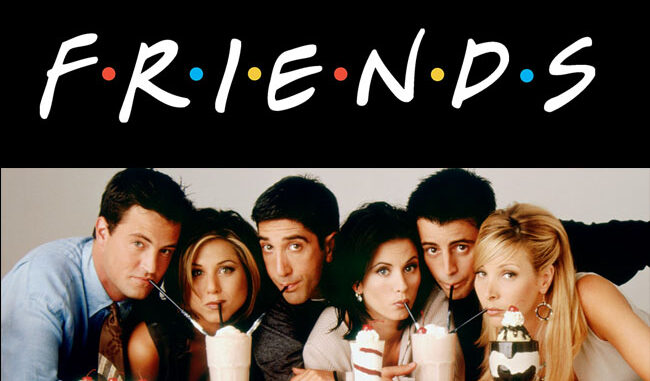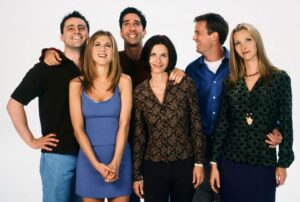
Friends: A 20th Anniversary Oral History

Twenty years ago in a Manhattan coffee house, a jilted husband named Ross whined to his friends that he desperately wished to marry again.
Then on cue, in walked a runaway bride named Rachel — setting the stage for a ten-year courtship that would captivate audiences the world over.
During that laugh-filled decade, Ross‘ sister Monica would fall in love with her pal Chandler. (Could he be any luckier?)
Bohemian Phoebe would serenade us with a song about a Smelly Cat. (Yay!)
And thanks to a dimwit actor named Joey Tribbiani, “How you doin?’” would become as popular a catch phrase as Homer Simpson’s “D’oh!” and Barney Stinson’s — wait for it… — “Legendary.”
With the 2002 Outstanding Comedy Series winner celebrating its twentieth anniversary on September 22, the sitcom’s creators, Marta Kauffman and David Crane, along with former NBC President Warren Littlefield, reflect on the phenomenon many have tried to duplicate without success.
Origin
The show’s creators, Marta Kauffman and David Crane, had made a name for themselves on NBC’s The Powers That Be and HBO’s Dream On.
David Crane (series creator): It was just another pilot for us. We had a very short-lived series called Family Album that was cancelled after six episodes. So we were scrambling in a panic wondering if they would ever let us back on the air again.
Marta Kauffman (series creator): We really wanted to do an ensemble comedy. This one was close to our hearts because we had lived it.
Warren Littlefield (president, NBC, 1990-98): Marta Kauffman and David Crane had a deal at Warner Bros. and came in and pitched the show in my office. They were so in sync. They were writing what they knew and what they lived in New York. It was a wonderful pitch and we just said, “That’s it!”
Crane: This was one of two pilots we were developing that season, the other being one for Fox that was not successful. This one just seemed to flow every step of the way and was easy to write, while the Fox thing was terrible. And we had this fear that NBC wouldn’t pick up their show and Fox would pick up the wrong one.
Kauffman: And we’d be miserable.
Crane: The one-line pitch was, it’s that special time in your life when your friends are your family.
We thought Chandler was going to be a quick, easy role to cast, and that wasn’t the case. Craig Bierko was very much a contender for Chandler. A lot of people loved him for that role; I was not one of them who loved that idea.
Kauffman: Matthew Perry actually coached Craig Bierko for his audition. It wasn’t what Bierko wanted to do at the time. He went to Broadway after that.
Crane: We played around with (Chandler’s sexuality) a little, but not in a real way. We talked about it when we were casting. But once we cast Matthew, I don’t think we ever considered making Chandler gay. But there is a Liza Minnelli joke in the pilot where Chandler’s talking about a dream.
Littlefield: Paul Reiser was exceptional about letting Lisa (Kudrow) move to Friends. He loved what she was doing on Mad About You, but it wasn’t a series regular character. And then they brilliantly came up with the notion that Phoebe and Ursula were sisters and she could pop up again on Mad About You.
David Crane said, “If (Ursula) had been my creation on my show, I don’t know if I would have been as generous as (Mad About You creator) Danny Jacobson was with us.”…
Kauffman: Phoebe’s twin sister, Ursula, ended up dating Joey for a little while.
Crane: I have no recollection of that.
Kauffman: Don’t you remember when Phoebe pretended to be Ursula?
Crane: Kind of…I feel really old.
Littlefield: We’d done a couple things with Jennifer (Aniston). We loved her and wanted her. The problem was she was tied to another series, so we took her in second position.
When it was time to go into production and start shooting episodes, she was still under an option at CBS and no one had been successful about getting her released. I was told that we had to replace her. There was too much risk. But I said, “No. We are not doing that.”
They said, “Well, do you want to personally guarantee that if she doesn’t get released that you’ll finance the reshooting of these episodes?’”And I was like, “Well, nooo…., but we will somehow figure this out.”
We were incredibly vulnerable and business affairs thought we were nuts. Every time we shot another episode with Jennifer, we put millions of dollars at risk, but it all worked out.
We also took Matthew Perry in second position to a futuristic hour (series) set at LAX, but we didn’t think that was much of a threat.
Crane: Had either of those projects gone forward we would have been in serious trouble
Six of One
Before it was titled Friends, several alternatives were considered….
Kauffman: Six of One, Across the Hall, Friends Like Us…
Crane: Insomnia Cafe…
Kauffman: My favorite one was the morning we were being told it was going on Thursday nights. (Executive Producer) Kevin Bright said they wanted us to change the title to Friends, and Kevin said, “If you put us on Thursday nights, you can call us Kevorkian for all I care.
Reaction
Friends premiered on September 22, 1994, sandwiched between Mad About You at 8 pm and Seinfeld at 9 pm.
Littlefield: The pilot had a “high weak” in testing, but that’s okay. Things don’t always test great, but we were hopeful…It was not an instant hit. Not an automatic. There was this slow, wonderful build. The more people who saw it, the more they fell in love with it.
Crane: I don’t think it was until midway through the first season that we realized this was something that was going to be bigger than we ever imagined, and 20 years later we’d be talking about it.
Littlefield: At the end of the first season, the theme song just exploded that summer on the charts. People also caught up with reruns and that’s when we moved it to 8 for season two, and it never left that time period. From that point on, they were the anchor for that night
Media Blitz
Every magazine, talk show and product wanted to get in bed with the Friends, which presented a real danger of overexposure and backlash.
Littlefield: The press was wonderful. They were popping up on all these magazine covers. It was just bubbling. But we were a little concerned that we were so white-hot in terms of the cover of Entertainment Weekly, Rolling Stone and all of these other magazines
Everywhere the talent went, there was such buzz. We said, “You know what? This could backfire.” So we started to back off of some of the press opportunities, and that is very unlike a network. You usually embrace all that
Our sense was, we’re not a flash in the pan and we didn’t want to burn out. We wanted to go the distance.
Kauffman: My biggest regret is the Diet Coke ad we did.
Crane: Yes. It was such a stupid move. They came to us and said, “Would you put the whole cast together in a Diet Coke commercial?” It seemed like it was going to be such a good idea — one of those iconic Coke commercials
And then as we were getting closer to doing it, it was looking shittier. And it turned out to be not just a commercial, but a contest. It was just not good and we were in too deep. And there was a big backlash — “Here are the Friends selling out.”
I am sorry we urged the cast to do it. That was an absolute low point. Everyone came away from it going, “That was pretty dumb and we didn’t need to do that.”
Kauffman: Playboy came to us and wanted to make Friends the cover. Kevin was really excited about the idea. And I’m a feminist and really was not excited.
So we made a deal. I was going to go to the three women, and if they wanted to do it, then they could do it without me because I was not going to be a part of it. And we ended up not doing it.
Location and Casting Stunts
The list of superstars who flocked to Friends over the years puts The Love Boat to shame. Among those who stopped by for a cup of coffee: Julia Roberts, Brad Pitt, George Clooney, Robin Williams, Charlton Heston, Sean Penn and Bruce Willis.
Littlefield: It was the place everyone wanted to be.
Kauffman: We got a call that Justin Timberlake wanted to do the show.
Crane: We had a meeting with him and he was lovely, but we didn’t have a good part for him.
Kauffman: My kids were furious. They wanted to kill me.
Littlefield: Going to England was absolute insanity. The show had a meteoric rise in the UK and they were treated like the Royals. And they could get anyone they wanted on the show. Richard Branson… Fergie…
Crane: I feel like Kevin championed the idea of going to London because the show was very popular there. In that case, we had Ross with Emily, so that (wedding) storyline felt very organic. If we could go back in time, I don’t think the show really needed the stunt casting of Fergie and Richard Branson. You get caught up in things.
Kauffman: We did not want to do Friends Go to Russia.
Crane: Or Friends Go to Hawaii.
All for One and One for All
In their original contract, the actors were paid $22,500 per episode, and different salaries in season two. Prior to negotiating for season three, the cast decided to negotiate collectively, despite Warner Bros. preference for individual deals.
Salaries were upped to $75,000 per episode in the third season, then $85,000 for season four. By season five, they were raking in $100,000 per show, then $125,000.
To return for seasons seven and eight, the six actors were awarded $750,000 per show and finally a whopping $1 million per episode for the final two years.
Littlefield: From day one, Marta and David put forth that this was truly an ensemble show. And very quickly the actors said we want to be treated all as equals. I think David Schwimmer knew exactly what would hold that cast together for many, many years to come.
Everyone involved with Friends made a tremendous amount of money, but it was really the wisdom of Schwimmer who said, “I don’t want to come in to a work environment where someone is making more. This is all our show and we should be treated the same.”
